What would scrambled eggs look like from jeweled eggs?
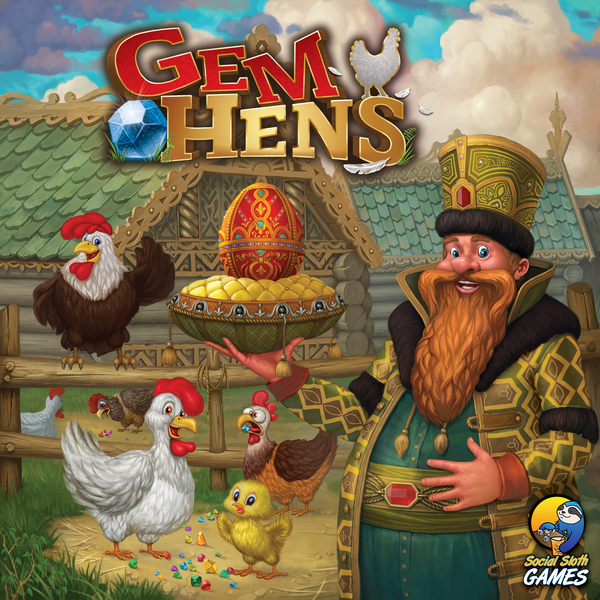
| Gem Hens (2019) | |||||
| Designer(s) | Jim DiCamillo, Patrick Marino | Artist(s) | Tyler Myatt | Publisher |
Social Sloth Games |
| 2-4 | 14+ | 30-60m | |||
You are a farmer trying to get your chicken to lay jeweled eggs by feeding them various precious gems. The shiniest and more ornate the egg, the more approval gained by a Tsar. What will your jeweled egg look like?
Box and Components
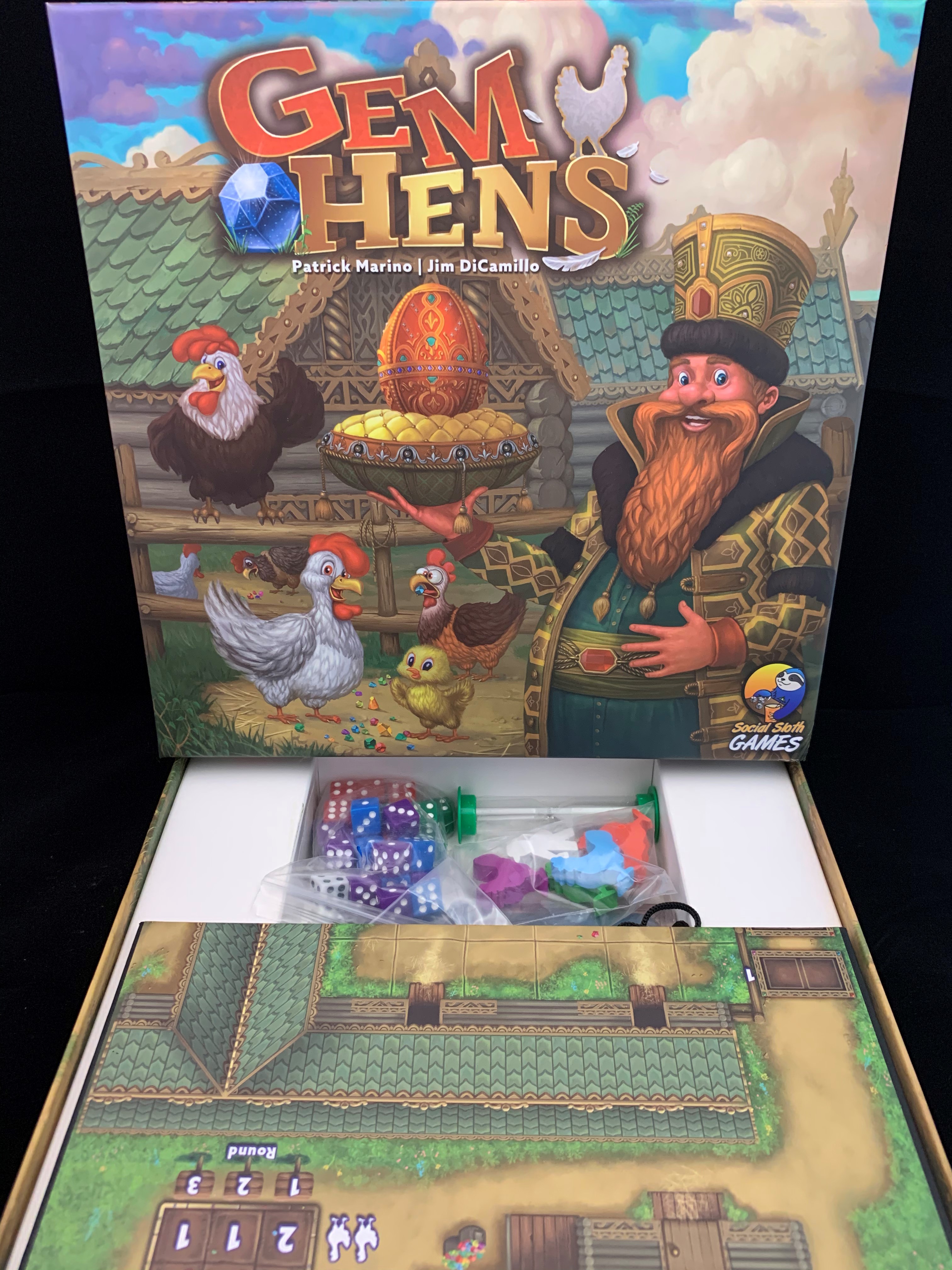 The box is sized well for the components; it uses a typical cardboard insert seen in many games with the smaller components placed into baggies. The components are good quality with a few minor issues.
The box is sized well for the components; it uses a typical cardboard insert seen in many games with the smaller components placed into baggies. The components are good quality with a few minor issues.
The components include:
- One Yard Game Board
- Four Player Egg Boards and Four Player Action Boards
- 100 plastic gems of various colors and cloth bag
- 38 six-sided dice (6 white farmer dice and four sets of 8 player dice in each player color)
- 5 wooden pawns (1 white farmer and 1 chicken pawns in each player color)
- One Timer
- Various cards and tokens
The chip boards used for the game board and the player boards are a good thick board that should be very resistant to bending. The plastic gems are good quality and are like those found in games like Quartz and Istanbul: The Dice Game; the cloth bag keeps these together nicely.
The two things that we found a less than ideal when playing the game.
- The chicken pawns are very cute and we like the shape; however, they don't stand very well. They tip over easily when touched on the board so we ended up just tipping it forward where it looks like the beaks are on the ground looking for feed; overall, this is fine because that is something chickens do anyways.
- The game board may have multiple gems and player chickens in the square spaces during the course of the game, but the spaces are a little tight for all of these things to fit. There is a lot of area on the board that is purely for aesthetics and could have been modified to allow the square spaces to be at least 1/4 bigger.
Beyond these two minor issues, the game's components are all suitable for the game.
Mechanics
The goal of the game is to collect a variety of gems to place onto your Egg Boards ("jeweled eggs") in clusters to earn points; gems are of different rarities and are worth more than others. Over the course of the game, players will walk their hens around the yard eating precious gems. After 3 rounds, whoever has the most valuable jeweled egg is the winner.
Setup
- Place the Yard Board in the center of the table within reach of all players.
- Each player takes an Egg Board, an Action Boards, a Chicken Pawn, and Dice (specific dice count is dependent upon player count) in their selected player color. Place Chicken Pawns in the chicken coop outside the grid on the Yard Board.
- Place the white farmer pawn in the round number table on the Yard Board in the row specific to the player count in the "1" column.
- Place the bag of gems and the remaining components within reach of all players.
Gameplay
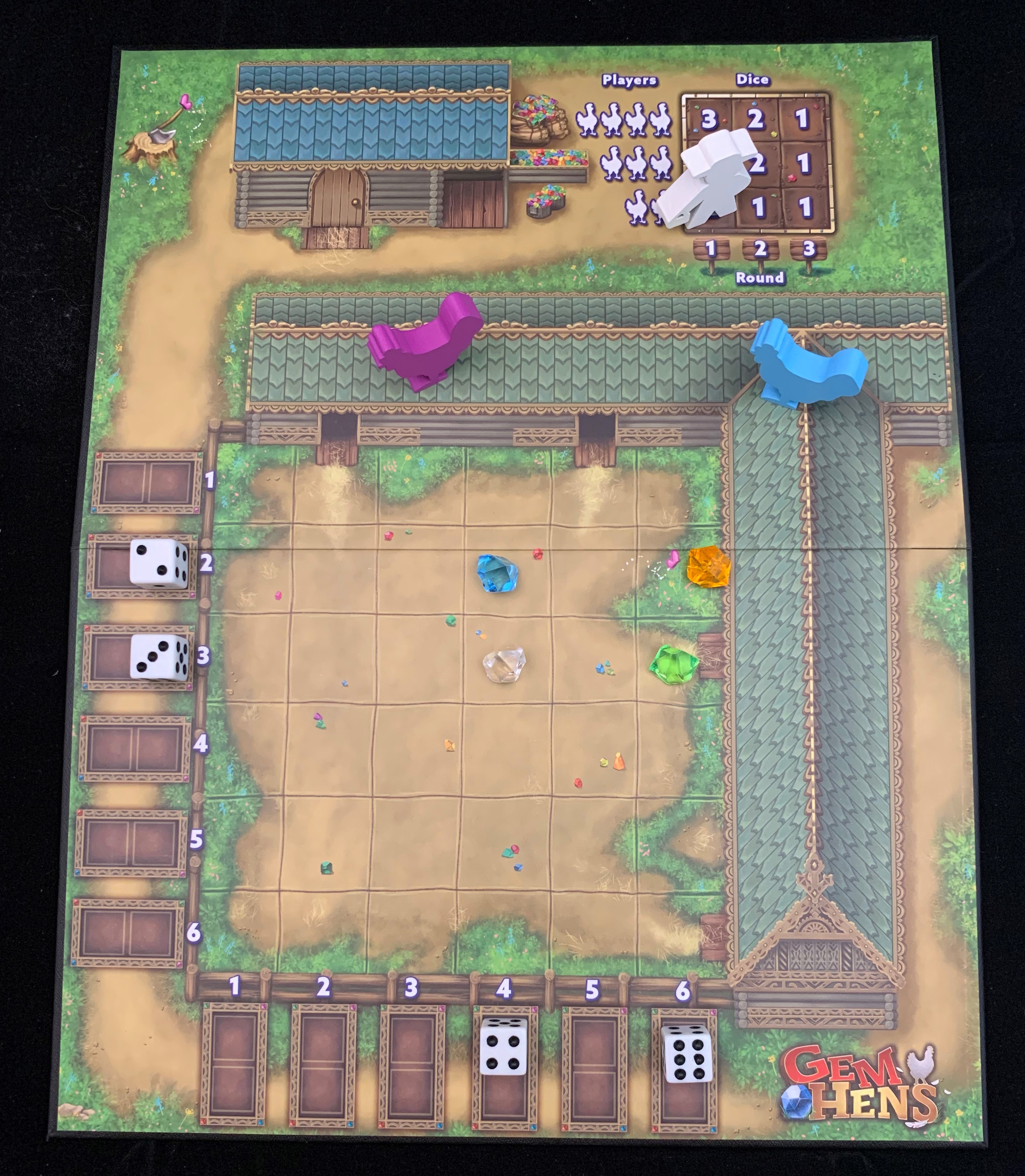 Each round is broken up into 3 phases.
Each round is broken up into 3 phases.
- Grain Throwing: Players will roll the white farmer dice for the rows and columns in the yard to populate the yard with gems. The number of dice rolled will be based on where the Farmer Pawn is on the round track table. If the farmer is on a two, players will roll two white dice for the rows and 2 white dice for the column. First, roll the number of dice for the row placing the dice in the row for the shown value, next roll the number of dice for the column placing the dice in the column for the shown value, and finally place a random gem from the bag in the spaces where dice in the row and column overlaps. In the rare event that more than two dice would be placed in the same row or column space, re-roll one of the dice.
- Chicken Dice Rolling: Players will roll and re-roll their own player dice quickly to gain different abilities shown on their player board. When rolling begins, the timer will be flipped, and dice can be rolled as many times as the player wants until they are happy with their results or the timer runs out. The actions for each value are as such and will be performed in the Chicken Actions phase:
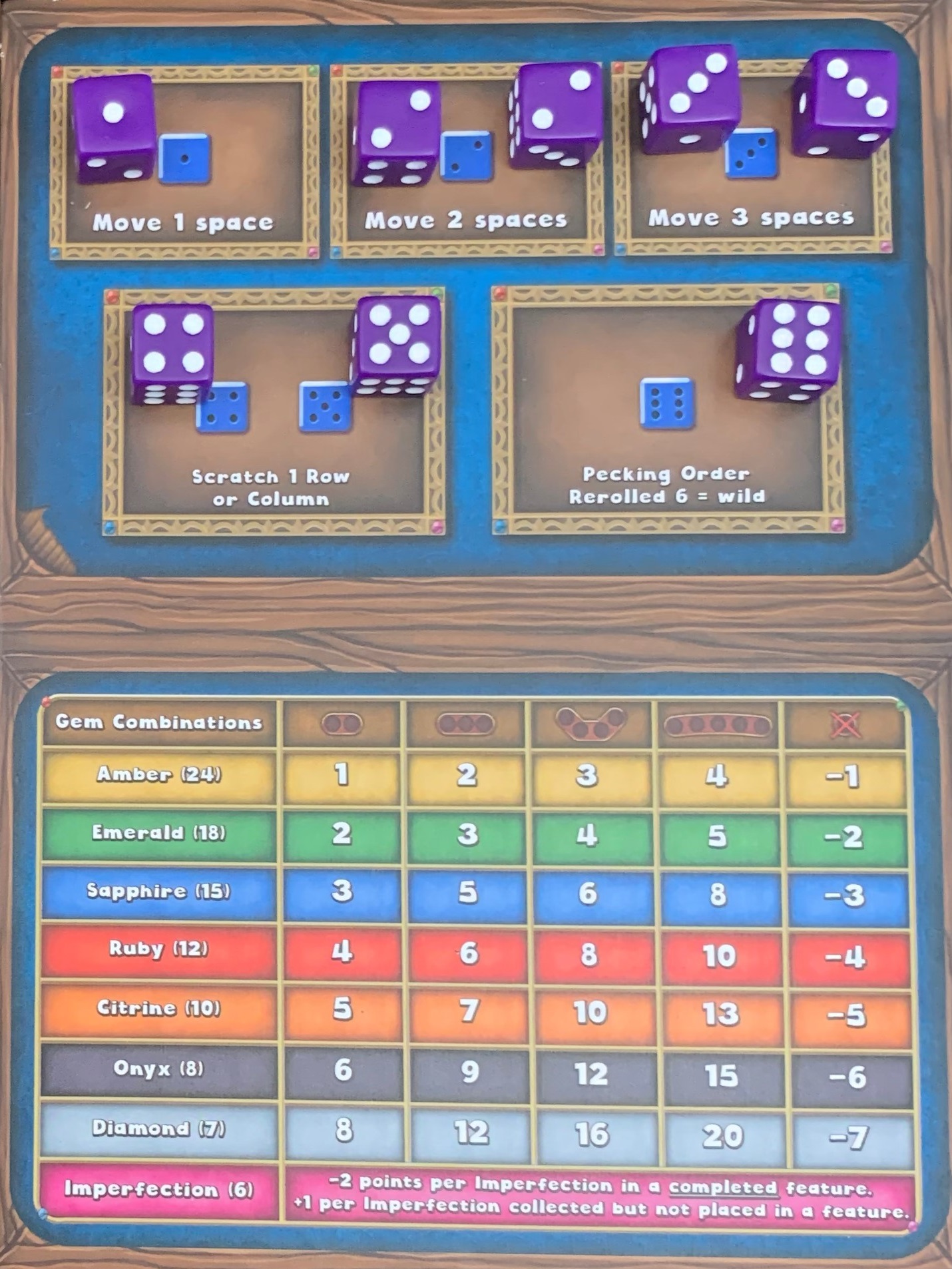 1, 2, 3 - Movement: Player is able to move their chicken a number of spaces matching the die value in a single direction horizontal or vertical (direction can't be changed for a single die).
1, 2, 3 - Movement: Player is able to move their chicken a number of spaces matching the die value in a single direction horizontal or vertical (direction can't be changed for a single die). - 4, 5 - Scratch Rows or Columns: Players can take one of these dice and place them in any row or column space to dig up more gems. Dice can be flipped to any value when used in this manner and placed in any open space in the numbered space around the yard. Gems will be populated in the yard like it was during the Grain Throwing phase at each intersection.
- 6 - Pecking Order: These dice have 2 functions.
- Before the Chicken Actions phase begins, players will take all of the "6" dice and roll them once and add up the value of all of those dice. The player with the highest value will take the #1 Pecking Order token, second highest will take the #2, and so on. These pecking order tokens are used to create the turn order for the Chicken Action phase. These dice are then placed in the spaces corresponding with their die face (all 1s placed in the 1 space on the player board, 2 to 2 space, etc.).
- Any 6's that rolled after the pecking order roll will return to the 6 space on the action board and can be used like a wild and may be used like it was a 1-5 value.
- Chicken Actions: Players will take turns based on their Pecking Order token and will resolve one of their action die in any order they choose; all action dice will be used each round.
- Movement (1-3): Players can use their 1-3 dice to move in a single direction a number of spaces equal to their shown value on the die. Movement must be fully taken unless the chicken hits the border or another chicken, where movement will stop; hens cannot share spaces.
- Shoving is a special optional action that can be taken in the event a player's movement is stopped before all movements are used. A player may choose to push another chicken by expending an additional movement dice from their pool to push the opponents chicken. The shoving die's value indicates how many spaces at most the opponents chicken can be pushed; however, this shoving space is limited to the same restrictions as normal movement (movement stopped at borders and when next to another chicken pawn). Additionally, the shoving movement is limited to how much further the players chicken had to move with their first die.
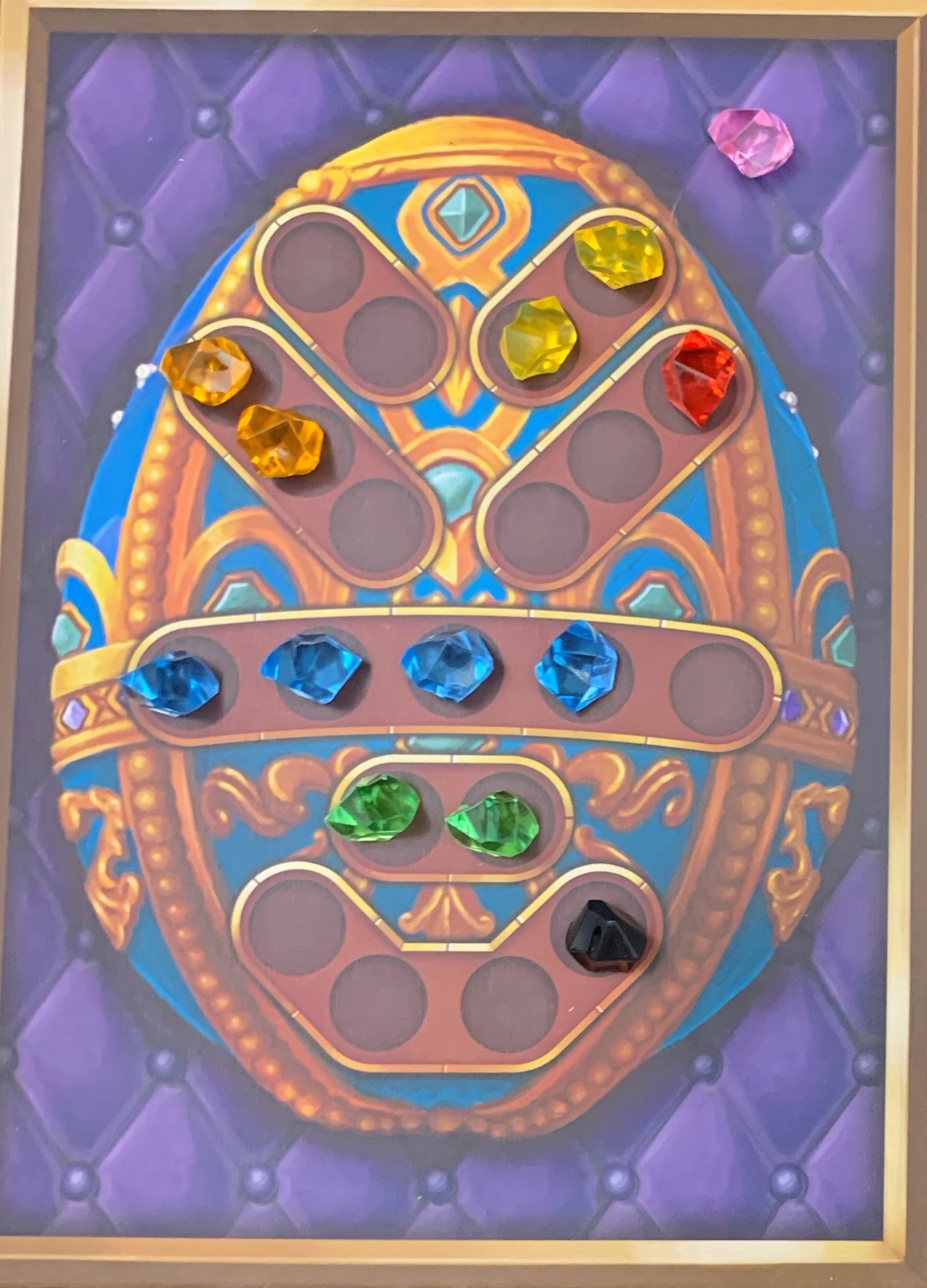 Eating Grain: When a Chicken ends their movement in a space with Gems, that player takes all gems in the space and places them on spaces on their Egg Board. The Egg Boards have sets (egg features) of spaces from 2-5 spaces; each of these sets may only having matching gems within each set. Gems don't have to be used on the board and can be set aside, but they will decrease your score at the end of the game.
Eating Grain: When a Chicken ends their movement in a space with Gems, that player takes all gems in the space and places them on spaces on their Egg Board. The Egg Boards have sets (egg features) of spaces from 2-5 spaces; each of these sets may only having matching gems within each set. Gems don't have to be used on the board and can be set aside, but they will decrease your score at the end of the game.
- Pink gems represent imperfections and can count as any type of gem to allow sets to be completed. However, after scoring is calculated for completed sets, subtract two points for each imperfections used in that set. Unused pink gems will actually gain you points at the end of the game.
- Scratch Rows or Columns (4-5): As described earlier, player can use these dice to place these dice in any open space in the row or columns on the Yard Board to dig up new gems; the 4/5's can be turned to any value on the dice to assuming there is open spaces in those rows/columns. The new gems are spawned like they were during the Grain Throwing Phase.
- Pecking Order (6): These dice can be used as a Movement or Scratch Rows/Columns action.
- Skip Turn: If you have used dice for optional actions and have no dice remaining, your turn is skipped.
- Movement (1-3): Players can use their 1-3 dice to move in a single direction a number of spaces equal to their shown value on the die. Movement must be fully taken unless the chicken hits the border or another chicken, where movement will stop; hens cannot share spaces.
At the end of the round, chickens are placed back in the coops, gems remaining in the yard remain where they are, and return the Pecking Order tokens beside the board. Move the farmer to the next columns in the round track table.
In the rare event that a player has completed all of their egg features on their Egg Board or there are no gems remaining in the bag, the game will end and go to scoring.
Game End
After the third round, players will review their eggs for completed egg features and unused gems.
- Earn points for completed egg features; refer to the values of completed features as shown on the Player Action Boards.
- Players lose points for unused gems; each gems have a different negative value also shown on the Player Action Board (last column). Unused imperfections (pink) actual earn players a point for each unused.
- Players lose two points for imperfections used within completed Egg Features.
Whoever has the most points is the winner of Gem Hens.
Advanced Variant
There are two variant rules players can use once they are familiar with the basic game.
- Fighting Action: Similar to shoving, players can optionally fight another chicken to attempt to steal gems from another players egg. After completing your action on your turn and while you are orthogonal to another chicken, the current player may declare they are fighting the neighboring chicken. This action can be taken once per turn. The attacking player will take any of their unused dice on their Action Board and roll it. Based on the value rolled, different actions are taken; imperfections can also be stolen. The actions taken correspond to the value rolled on the die:
- Defender chooses which gem to give to the attacker.
- Defender chooses a gem from a 2 Set Egg Feature.
- Defender chooses a gem from a 2 Set Egg Feature.
- Defender chooses a gem from a 2 Set Egg Feature.
- Defender chooses a gem from a 2 Set Egg Feature.
- Attacker chooses a gem from the defender's Egg Board.
- Power Clucks: These are optional cards can be used to change up the way the game plays providing special abilities. These cards are flipped over after each Grain Throwing Phase. Once players receive their Pecking Order tokens, players will claim these Power Clucks cards in reverse order (4, 3, 2, 1). The gained ability is in effect for that round and then discard during clean up. The abilities are fairly straight forward as written on the cards.

Final Thoughts
Gem Hens is nice game that looks good and has a fun theme that I haven't personally seen in another game. The game is very easy to learn but provides some additional variants to make the game a little more strategic; I believe once players are familiar with the game, they will always play with the two optional rules since the Power Cluck cards simply add much needed variety to the game. I don't necessarily agree with the age rating being 14+ because I feel children 10+ should be able to play the basic game with a little initial support, but I imagine the age rating is reflective of some sort of guidelines.
The two minor issues I have with the game doesn't distract from what the game provides, but they do seem like issues that should have been caught during playtesting.
Overall, I really enjoy the game and will be demoing it at our Extra Life events in the future. 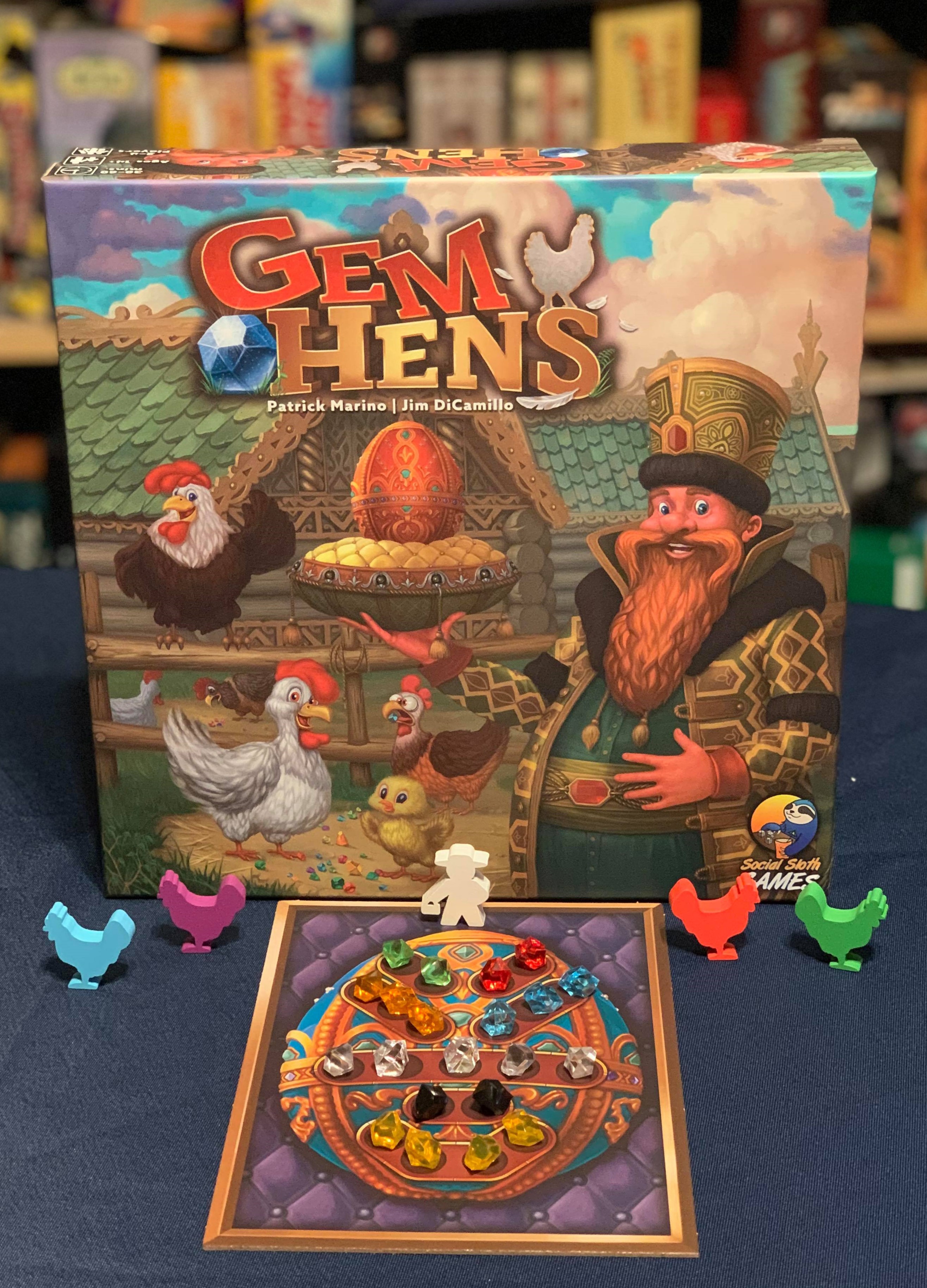
Links/Media
Disclosure
We received the product in order to write an honest review; all reviews reflect the honest opinions of the writer.
WVGamers is a participant in the Amazon Services LLC Associates Program, an affiliate advertising program designed to provide a means for sites to earn advertising fees by advertising and linking to Amazon.com.
